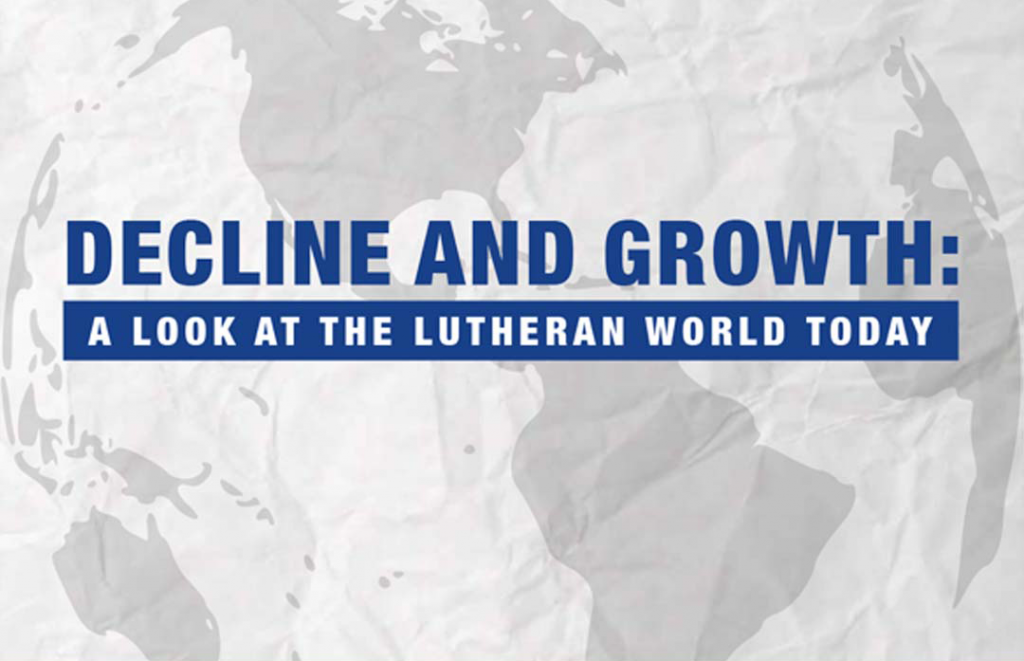Decline and Growth: A Look at the Lutheran World Today

by Mathew Block

If I ask you to describe a typical Lutheran, what do you imagine? Do you assume it would be someone of German or Scandinavian descent? If so, think again. Today, the typical Lutheran—at least the one actually in church on Sunday morning—is far more likely to be someone from Africa. In fact, the world’s largest Lutheran church body today is in Ethiopia.
A lot has changed in the five centuries since the Reformation began. From Wittenberg, Martin Luther’s ideas spread throughout Europe. The Lutheran church which sprang up in response established deep roots in Germany as well as in the Nordic nations and Baltic provinces. Over the next few centuries, Lutherans would eventually go on to proclaim the Gospel in other lands—other continents—leading to the birth of Lutheran missions and churches throughout the world.
As time went on, however, not all of these churches remained faithful to their Lutheran heritage—nor to the Scriptures which inspired the Reformation. Church mergers led to a decline (or sometimes even a ban) on Lutheran teaching and practice. New theologians arose who questioned the historicity of the Bible. Less and less emphasis was placed on the Lutheran Confessions as authoritative in the life of the church. Fast-forward to today, and we find state and mainline Lutheran churches which sometimes seem to focus more on contemporary politics than on Jesus Himself.
The situation in Europe and North America
The departure from biblical teaching by European Lutheran state churches has resulted in a steady decline in religiosity among rank-and-file members. After all, if what you’re taught from the pulpit isn’t substantially different than what contemporary culture already tells you, why bother going? Many of these people are still counted as members by the state church for historic reasons; but they never or seldom attend. The result in Europe is church bodies which look large on paper but whose buildings are surprisingly empty come Sunday morning. Without church taxes and continued government support, many of these state churches would find it impossible to continue.
Consider, for example, Finland, historically a majority-Lutheran country. Even today the national church—the Evangelical Lutheran Church of Finland—officially counts 3.74 million members, or 67.8 percent of the nation’s entire population. But almost none of these attend church. The result is cavernous cathedrals with just a few dozen worshippers in attendance at Divine Service. The population at large has abandoned the church.
Studies have shown that denominations which are more conservative theologically and which hold a higher view of biblical authority have greater resisting power to the effects of declining religiosity in wider society.
That goes a long way to explaining how a Lutheran bishop in Finland has ended up on trial for his Christian faith. Bishop Juhana Pohjola of the Evangelical Lutheran Mission Diocese of Finland (ELMDF)—a partner church of Lutheran Church–Canada—along with Finnish Member of Parliament, Dr. Päivi Räsänen, have been charged with hate crimes for publishing a booklet outlining historic Christian teaching on human sexuality. And there is no outcry, despite the country’s purportedly majority-Lutheran population.
We see the same decline at work in mainline Lutheranism in North America. The Evangelical Lutheran Church in Canada (ELCIC) stopped publishing its statistics online in 2015, but the Lutheran World Federation reports that, as of 2019, the ELCIC had 95,000 members. That’s down more than a third since 2009’s report of 148,474 members. The Evangelical Lutheran Church in America (ELCA), meanwhile, reports a membership of 3.14 million members as of 2020—a drop of more than a million members over ten years (from 4.27 million in 2010). The trajectory is so concerning that the ELCA itself has estimated it will have fewer than 67,000 members total in the United States by 2050—with fewer than 16,000 people in worship as early as 2041.
Of course, membership loss is not just affecting mainline Protestant churches; a similar story is taking place in North America’s confessional Lutheran churches, albeit far less precipitously. The Lutheran Church—Missouri Synod, for example, reports a membership of 1.86 million members in its 2020 Annual Report, down 18 percent from 2010’s membership of nearly 2.28 million members. Our own church body, Lutheran Church–Canada, meanwhile, has dropped to 51,640 members as of 2019 from 68,735 in 2009—a drop of nearly 25 percent over ten years.
To be sure, the decline of confessional Lutheranism in North America is slower than that of our mainline counterparts. That’s not particularly surprising: studies have shown that denominations which are more conservative theologically and which hold a higher view of biblical authority have greater resisting power to the effects of declining religiosity in wider society. Confessional Lutherans take pride in our solid grounding in the authority of Scripture and the Book of Concord—and rightly we should. But we have not always passed on that faith as diligently as we should. Our membership losses are a rebuke to our failure over many decades to provide rigorous catechesis and Christian formation to our members, especially our youth. It also speaks to a failure on our part to equip members to winsomely share the Gospel with their neighbours.
Further Afield
When we look at North America and Europe, it’s easy to become depressed. But the Lutheran story is far from over; it’s just that the main drama has shifted elsewhere. The Lutheran church is growing, and growing dramatically, in other parts of the world. We’ve already said that the largest Lutheran church body in the world is in Ethiopia. But the story of the Ethiopian Evangelical Church Mekane Yesus (EECMY) is itself something of a miracle. At its founding in 1959, it counted about 20,000 members. When the country fell to communism, the church suffered brutal persecution; even the church’s General Secretary, Gudina Tumsa, was murdered in 1979. But the church not only survived; it grew. By 2007, the EECMY had nearly 2.3 million members. In 2013, that number had grown to more than 6.1 million. Now, as of 2019, the church reports a membership of 10.4 million members.
We see a similar miracle taking place in Madagascar. The Malagasy Lutheran Church (FLM) had 495,000 members in 1979. By 2001, that number had tripled to more than 1.5 million. As of 2019, the FLM has an estimated membership of 4 million people.
Similar stories could be told of many other churches in many other nations, if on a smaller scale. In Mozambique, for example, a mission planted by Lutheran Church–Canada’s own Rev. Joseph Khembo Alfazema and now watered by our friends from the Evangelical Lutheran Church of Brazil is leading to a marvelous harvest of faith. In 2015, the mission had about 1,000 members. As of 2021, the Concordia Christian Church in Mozambique has grown to nearly 44,000 members! At that rate, they may well overtake our numbers in LCC in just a few years.
As of 2021, the Concordia Christian Church in Mozambique has grown to nearly 44,000 members! At that rate, they may well overtake our numbers in LCC in just a few years.
We can and should celebrate stories like these, as the Holy Spirit blesses the proclamation of the Gospel in other lands and draws believers into the Christian church. We can and should thank God for the blessings He is showering upon these people. And we can and should pray to God that He would keep Christians in these places—and in our own land—steadfast in Christ and faithful to His Word despite the challenges they face.
And let us be clear: even growing churches like these face challenges. A lack of financial resources. Military conflicts. The spread of heterodox teaching. Theological pressure from outside organizations. The threat of Islamic terrorism. A lack of qualified church workers. The difficulties of reaching out in a pandemic, especially in places without reliable internet access.
Nor should we mistake the blessings of these growing churches to mean that all churches in Africa are growing. Plenty face the same plateau or even decline that we in the West face. They too are suffering hardship. So, even as we “rejoice with those who rejoice,” we must also “weep with those who weep” (Romans 12:15). Pray that God will sustain those faithful pastors who continue to preach the Word of God clearly and administer the sacraments rightly in the midst of an unwelcoming wider society. Pray for those faithful few who attend when others have fallen away. And, dear Holy Spirit, move them to pray for us too.
One Lord, One Body
The Lutheran world is certainly changing. And we haven’t space here to fully explore the joys and challenges facing Lutherans living in Asia or South America or Eastern Europe: joys, for example, like the launch of a new hymnal which will unite Spanish-speaking Lutherans across Latin America in closer partnership; challenges, for example, like the hostility of non-Christian majorities in some parts of Asia. But we thank God that, wherever Christians may gather, God has promised to be present among them with His grace and His mercy. He is present in the Word of Scripture, creating and sustaining faith. He is present in Baptism, granting forgiveness of sins and uniting us to Christ. He is present in Absolution, bestowing mercy on penitent sinners. He is present in the Lord’s Supper, filling and strengthening us with the life of Christ.
We can and should celebrate stories like these, as the Holy Spirit blesses the proclamation of the Gospel in other lands and draws believers into the Christian church.
For these reasons, we know that Christ is with us also, whatever challenges our own region of the Lutheran world might be experiencing. But even during this time of decline among Lutherans in the West, God sends glimmers of joy. In Germany, for example, our partner church—the Independent Evangelical Lutheran Church—saw a multiyear membership decline arrested by the miraculous conversion of thousands of Iranian and Afghani refugees to Christianity. We in Canada have likewise been blessed to welcome numerous immigrant groups into our church family—the Oromo in Winnipeg, for example, and the Nuer in Edmonton, among many others. May God continue to enrich our fellowship with these faithful Lutherans out of other lands! May He continue to draw us together as one body in Christ.
You can learn more about that united body through the website of the International Lutheran Council (ILC) at www.ilcouncil.org. LCC is a longtime member of this worldwide association of confessional Lutheran churches. If you want to learn more about your faithful Lutheran sisters and brothers around the world, the ILC’s website is a good place to start. And the story has a lot of good news. In 2018, for example, the ILC welcomed 17 new church bodies into membership—including the Malagasy Lutheran Church, highlighted above. Several others have applied for membership since then, including most recently the Evangelical Lutheran Church of Latvia. The ILC’s faithfulness to Scripture and the Lutheran Confessions makes it a fruitful and encouraging meeting ground for faithful Lutherans from across the world.
May God bless the ministry of all such faithful Lutherans wherever they may be. For whether we are small or large, rich or poor, joyful or suffering, we are all one body together in Jesus Christ—one witness to the world of the One who came to save the world.
———————
Mathew Block is editor of The Canadian Lutheran and the Communications Manager of the International Lutheran Council (ILC).





